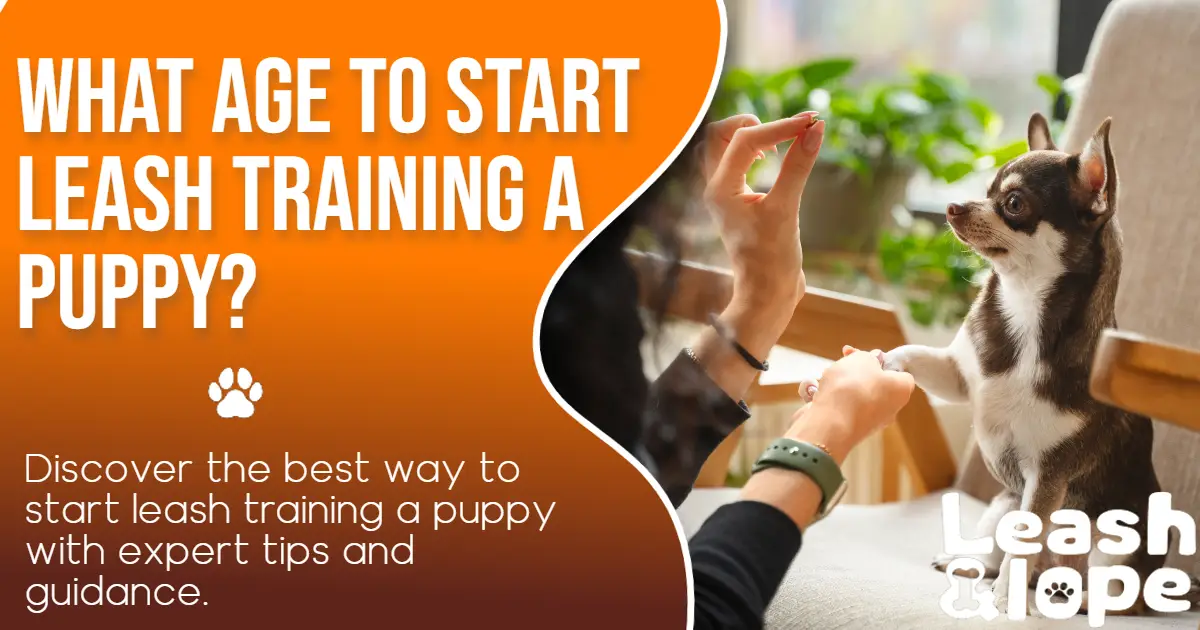Have you just got a new puppy? It must be cute seeing this little ball of fur running around your house.
But when it comes to taking him out for a walk, I’m sure there must be some chaos about whether it’s the right time to start leash training a puppy or not. If it’s not dealt with, it can lead to the progression of unwanted behavior in his adult life.
In general, most dog expert recommends starting leash training your puppy between 6-8 weeks of age. but, make sure they are fully vaccinated before they are introduced to leashes, harnesses, or exploring the world with you.
Why is it necessary to leash train your pup at 8-10 weeks?
As we know it’s best to start leash training a pup at the age of 8-10 weeks, delaying this process can have significant challenges. Although it’s fine to start the training anywhere between 8-14 weeks, the following points prove the significance of starting the training process early and more importantly—in a proper way:
- During that 8-14 week period, puppies are like sponges, soaking up all the new experiences and learning how to navigate the world around them.
- By introducing them to the leash early on, you’re helping them get used to the sensation and teaching them that it’s a normal part of their routine. It’s like showing them that leashes are their little adventure buddies.
- Starting early gives you a head start in building good walking habits and preventing any leash-related struggles down the road if you patiently keep working on correcting any unusual behavior that the puppy may show during the training.
- Behavioral commands play a big role in teaching your furry friend how to walk nicely on a leash. Using clear and simple commands like “sit,” “stay,” and “heel” will help your pup understand what you expect from them during walks. Hence, if you end up training them to respond properly to your commands at this young age, they’ll be far easier to handle in their adult age. This is because, just like us humans, puppies get accustomed to what’s been taught to them in their younger age. So, if your puppy tries to go towards the distractions he encounters, you can call him back by using these commands.
- An 8-14 week period is a critical time for their development, especially when it comes to getting them comfortable with being on a leash. By exposing them to different people, animals, and environments during this time, you’re helping them build positive associations and confidence with the whole leash-walking gig. It sets them up for success in the future and makes walks a breeze for both of you.
- Puppies are still exploring the world with their curious little paws. They might not have fully developed street smarts yet, so having them on a leash helps prevent potential accidents or dangers. It gives you better control and ensures they stay close by your side during walks. Plus, it’s an excellent opportunity to teach them good leash manners and keep them out of harm’s way.
Phases of Development
If you’ve got a new puppy, you should start the leash training as soon as you can and shouldn’t wait for him to become an adult. This is because there are 3 phases a puppy goes through before he becomes an adult. All of these phases hold great significance in the puppy’s behavior and overall training. These phases are:
- Primary phase
- Socialization phase
- Enrichment phase
Primary phase:
- It starts from the birth of the puppy and lasts for 3 weeks. Puppies usually rely on their mother during this phase.
- According to research, if puppies are handled with care during this period then they exhibit calm behavior when they’re 8 weeks old, which is during the socialization phase.
Socialization phase:
- It’s quite important phase. It starts when the puppy is about 4 weeks old and lasts till approximately 14 weeks.
- During the early part of this phase, the leash should be introduced to the puppy gently. Before you do this, you also have to make sure that your puppy has developed a bond of love and trust with you because this phase is very crucial in this aspect. If you don’t deal with your puppy with love and care, your puppy can develop fear which can create such a big chaos in his later life as well.
- This is because, during this phase, a puppy is quite aware of his surroundings. Any traumatic experience can alter their calm or playful behavior, which can become established in adulthood.
- After introducing him to the leash and harness, you can start the leash training.
- It’s also the perfect time to start training your puppy to respond to basic obedience commands.
Enrichment Phase:
- It starts from approximately 14 weeks and lasts till 12 months.
- During this phase, the puppy doesn’t show complicated responses to new stimuli. He can adapt to new situations and learn new things easily only if they’ve been dealt with properly and taught new things in the previous periods.
- Hence, you can start taking your pup out in the neighborhood and increase their leash training by exposing them to new surroundings.
Related: How To Stop Puppy Biting on a Leash
How to Introduce a Leash to The Puppy:
- At approximately 8-10 weeks of puppy’s age, start by simply holding the leash near your furry friend, letting them sniff and investigate it.
- Attach a couple of delectable treats to the tip of the leash and allow your adorable pup to explore and engage with it.
- This way, they can sniff, investigate, and even have a little playtime with their newfound leash buddy.
- Once they seem comfortable and curious, you can slowly and gently put the leash on them.
- Puppies are usually not too keen on wearing a leash initially, but it’s important to stay patient and persistent. Avoid forcing them or putting too much pressure on them.
- It’s essential to reward your puppy when they’re wearing the leash without any protest. This way, they’ll learn to associate the leash with positive things and feel more comfortable wearing it.
How to Train The Puppy to Walk on a Leash:
Now that you’ve introduced the leash to the puppy, let’s see how you can train the puppy to walk on a leash.
- Start walking with your puppy on a leash in your house. This is because leash training can be a bit overwhelming for puppies at first, so starting indoors helps create a familiar and controlled environment. It allows the puppy to get comfortable with the leash without any distractions or outdoor elements.
- Keep these sessions short and use positive reinforcement. Whenever your puppy walks nicely on the leash, reward them with treats and praise. This will reinforce good behavior and make them more eager to walk on the leash.
- Now, you can start taking your pup out in the neighborhood for a walk, to see how your pup will behave on leash with different distractions. Don’t increase the distractions abruptly—do it gradually.
- It’s important to take the puppy out of the house and introduce them to different environments because they may be fearful or over-excited in new situations. Additionally, exposure to different sights, sounds, and smells can help socialize the puppy and reduce the likelihood of them becoming reactive or fearful.
- Patience, consistency, practice, and routine—are the magical ingredients for successful leash training. When it comes to teaching your pup how to walk on a leash like a pro, these factors play a key role.
- First up, patience. Training takes a lot of time. Every pup learns at their own pace. So, be patient with your furry friends as they figure out this whole leash thing. It’s all about positive reinforcement and giving them time to adjust.
- Next, consistency is crucial. Stick to the same training methods and cues so your pup understands what’s expected of them. Consistency helps them form good habits and makes the training process smoother.
- Practice makes perfect! Regular practice sessions help reinforce the training and build your pup’s confidence. Take short walks, gradually increasing the duration as they get more comfortable. Remember, little steps lead to big strides.
- Lastly, establish a routine. Dogs thrive on routine, so having a consistent schedule for walks and training sessions helps them feel secure and know what to expect.
- Sometimes, despite our best efforts, we may encounter challenges or have difficulty getting our furry friends to cooperate. That’s where the pros come in. Dog trainers who specialize in leash training can provide valuable guidance and expertise. They have experience working with different breeds and temperaments, so they know the ins and outs of effective training techniques. They can assess your pup’s specific needs and tailor a training plan just for them. Plus, they can offer personalized tips and tricks to address any behavioral issues that may arise during the process. So, if you find yourself struggling or wanting some extra support, reaching out to a professional trainer can make a world of difference.
What if the Puppy Doesn’t Behave Calmly on a Leash?
- It’s a very common issue that many dog owners face. Puppies may stay calm indoors but when we take them outside, they can show such behavior. This can include a variety of behavioral problems that puppies show while they’re walking their owners on leashes.
- A puppy may start pulling on-leash and drag you around with him. This can be dangerous for the safety of you and your puppy.
- If your pup is hyperactive by nature, then it can be another challenge to have a smooth leash training process. Rest assured, we’ve got this covered as well. Take a look at this informative piece of writing which will prove to be of great help.
- What if your pup starts lunging on the leash? No need to worry! See this article to ensure a great training experience with your pup!
Conclusion:
We’ve reached the end of this guide, emphasizing the importance of starting early. In conclusion, starting the leash training early is an essential part of raising a well-behaved and happy pup. Delaying the training process or neglecting the proper way of training can lead to devastating outcomes.
It not only ensures their safety but also promotes good behavior and strengthens the bond between the owner and their furry friend. By following the steps outlined in this article, pet parents can set their puppies up for success.
Remember, every dog is unique, so it’s important to tailor the training approach to suit their individual needs and personality. With time, practice, and lots of love, you’ll be strolling down the sidewalk with your well-trained pup by your side in no time.

Dr. Haider is a general doctor with a unique level of connection to our four-legged friends. He is a valued contributor to our Website (Leash and Lope). Dedicated to providing accurate to dog owners in understanding and caring for their lovely pets.

